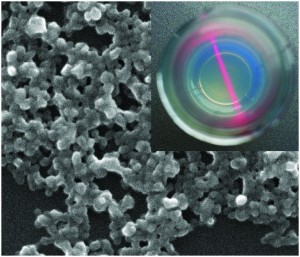Posted on behalf of Gwenda Kyd, web writer for CrystEngComm
Porous metal-organic frameworks (MOFs) have potential applications ranging from gas storage to chemical sensing. To fully realise these, the ability to cast into a given form, such as a thin film, is important. Nanometre (nm) sized particles are an attractive target, potentially allowing properties to be fine-tuned precisely. Formation of MOF nanoparticles has previously been achieved but obtaining sizes below 100nm is difficult and can lack reproducibility.
A new paper shows how the MOFs HKUST-1 and IRMOF-3 can be produced using additive-mediated syntheses. These involve mixing a polymer (for the synthesis of HKUST-1) or polymer-surfactant combination (for IRMOF-3) with the metal and ligand sources. This produces nanoparticles of the MOF between 30nm and 300nm, depending on the reaction temperature, reaction time and the quantities of additives used. The synergy of the polymer and surfactant gives the best control over size and monodispersity, i.e. the particles produced are within a narrow size range. This method could potentially be useful in producing MOFs for drug delivery or sensing where ultra-small particles or films are required.
For more information see the full paper:
Additive-mediated size control of MOF nanoparticles
Annekathrin Ranft, Sophia B. Betzler, Frederik Haase and Bettina V. Lotsch
CrystEngComm, 2013, Advance Article
DOI: 10.1039/C3CE41152D, Communication
 Gwenda KydGwenda Kyd has a PhD in metallocarborane chemistry from the University of Edinburgh. Other research work includes the spectroscopic study of the structure of glasses and organometallic electron-transfer reactions and the preparation of new inorganic phosphors. Currently she works as a scientific database editor.
Gwenda KydGwenda Kyd has a PhD in metallocarborane chemistry from the University of Edinburgh. Other research work includes the spectroscopic study of the structure of glasses and organometallic electron-transfer reactions and the preparation of new inorganic phosphors. Currently she works as a scientific database editor.











